Pet parents, listen up! Caring for your pup means more than just grabbing whatever store-bought dog food is on sale and hoping for the best. What, when, and how you’re feeding your dog matters.
How to Control Portions for an Ideal Weight
Considering the type of dog food, dog food portion size, and how much food your dog needs by weight can make a huge difference in dog weight management. Other simple steps, such as using a slow feeder dog bowl, increasing exercise, and avoiding human food, can help your dog lose or manage their weight.
In this article, we’ll go through everything you need to know about helping your dog manage their weight, as well as some common questions you might have:
- How Many Calories Should My Dog Eat Daily?
- Calculate Portions by Weight & Breed
- Downloadable Feeding Charts
- How to Tell if Your Dog is Overweight
- Common Causes of Weight Gain in Dogs
- Weight Loss Tips for Overweight Dogs
- How to Help Your Dog Lose Weight
- Best Dog Food for Weight Loss
How Many Calories Should My Dog Eat Daily?
Simply put, there is no one-size-fits-all answer for how much to feed a dog. It all depends on factors like your pup’s breed, age, and daily activity level.
And as a pet parent, you’re responsible for feeding your dog the right proportions and nutrients. Maybe you have a picky pup that needs some coaxing and convincing to down a meal. Or maybe your dog has a sensitive stomach that needs some TLC. Or maybe you’ve got an overzealous eater who needs some boundaries put in place.
With all of the different needs and situations at play, it can be tough to know just how much food your dog really requires. And while it’s always best to consult your vet, here are some general guidelines for a dog who has an average activity level, with actual needs based on specifics like breed, life-stage and body condition:
- Extra-small dogs (5 to 10 pounds) – 160 – 200 daily calories
- Small-medium dogs (10 to 30 pounds) – 320 – 480 daily calories
- Medium-large dogs (30 to 50 pounds) – 640 – 800 daily calories
- Large dogs (50 to 70 pounds) – 960 – 1120 daily calories
You get the gist!
| Tip: Want to make things even easier? Let Pet Plate help. Fill out a few important questions, such as your dog’s breed, age, weight, body condition and activity level, and we’ll create a customized meal plan for you. Then sit back and wait for your doorstep delivery. It’s that easy! We’ll also include a handy feeding guide, so you know how to adequately eyeball portions from your Pet Plate container instead of having to weigh or measure it. |
How to Calculate Dog Food Portions by Weight & Breed
Curious about how much you should be feeding your dog? One of the best ways to determine how much you should feed your dog is by looking at your dog’s weight or ideal weight if they are overweight and referencing a dog feeding chart. The charts below provide recommendations by breed and stature. Remember to adjust for age as well. If you’ve got a puppy who isn’t quite at their adult size yet, you may want to adjust up or down based on their activity and growth rate
Use the following dog feeding chart by weight to estimate how much your dog should eat daily. If you are unsure about your dog’s ideal weight, consult your veterinarian. Your vet is the most knowledgeable source for this, but we’ll give you some baselines here. The downloadable charts below are categorized by breed type and then broken down further by the size of your dog, from extra-small to large:
Feeding Chart for Sporting Breeds
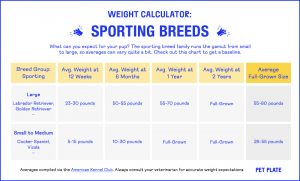
Feeding Chart for Hound Breeds
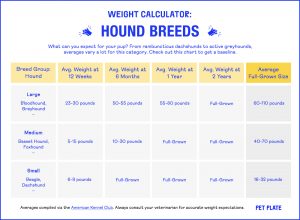
Feeding Chart for Terrier Breeds
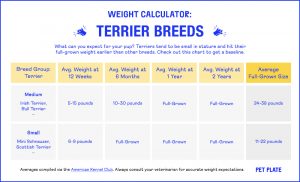
Feeding Chart for Toy Breeds
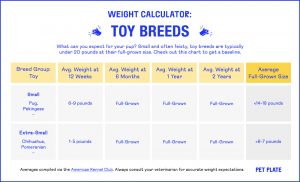
Feeding Chart for Non-Sporting Breeds
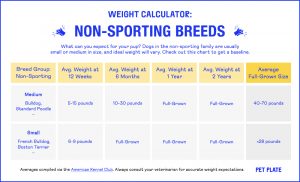
Feeding Chart for Herding Breeds
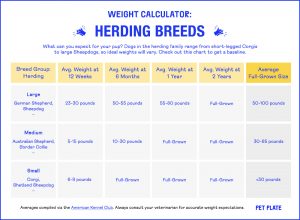
As you’ll see from the charts, there’s a lot of variances. Dogs in the herding family, for example, range from short-legged Corgis to large Sheepdogs, so ideal weights will vary. Again, you should always consult with your veterinarian for accurate weight expectations, especially if you have a mixed breed.
How to Tell if Your Dog is Overweight
So, how do you know if your dog is overweight and should lose a couple of pounds to improve their health?
The following tips by the American Kennel Club can help you check your dog’s weight visually by looking for common overweight dog symptoms:
- Look at your dog’s body shape. Look at your dog from above and note if your dog has a defined waist near their rear and a straight build on the sides. If they do, this means they are likely at a healthy weight. If you notice your dog has an oval or round shape, they are likely overweight.
- Can you feel your dog’s ribs? A healthy dog won’t have protruding ribs, but you should be able to feel their ribs without needing to press hard. If your dog is overweight, it will be hard to feel their ribs without a lot of pressure due to their excess body fat.
- Look at your dog from their side. Does your dog have a swinging or sagging stomach? A dog at a healthy weight will have a slightly raised stomach, while an overweight dog may have a prominent belly.
- Check for fat pads. Some overweight dogs will have sacks of fat located between their legs or on the top of their hips.
- Assess your dog’s activity. Is your dog spending more and more time inactive, lounging on the couch? If your dog is lethargic, has trouble breathing, or struggles to walk comfortably, this could be a result of extra weight.
Common Causes of Weight Gain in Dogs
Like all journeys of healing, it’s often important to understand the cause to be able to formulate the most helpful solution. Let’s start by going over some of the most common reasons dogs gain extra weight.
Common reasons dogs gain weight:
- Weight gain after being spayed or neutered
- Overfeeding (provided with too much food)
- Overeating (given too much of the wrong kinds of food, such as too many treats or table scraps)
- Undiagnosed Hypothyroidism
- Genetics (some breeds are more prone to gaining excess weight than others)
How to Transition to Smaller Portions
Once you know your dog’s ideal weight, you can start to reduce the food and treats you’re giving them, along with making other healthy lifestyle swaps to help them lose weight. Do not dramatically cut back your dog’s food, as this can upset your dog’s metabolism, making weight loss more difficult.
Ideally, a dog should lose about three to five percent of their body weight each month. For example, a 100-pound dog should lose about a pound a week or four pounds per month. While this may not seem like a lot of weight, remember that slow and steady weight loss is far more sustainable and healthier for your dog than fast, extreme weight loss.
Weight Loss Tips for Overweight Dogs
Next, we’re going to share seven healthy tips to help your dog lose some of the weight they may have gained. Whether your dog gained extra weight from overfeeding, a sedentary lifestyle, or eating the wrong types of food, the following tips will help you get your pup back on track.
1. Exercise portion control with both food and treats
Portion control on its own can be powerful. We often don’t realize how much our dog is eating until we start tracking how much we feed our dog. Don’t forget to include extra calories from table scraps, treats, or other human food your dog may beg for.
We recommend pre-allocating your pup’s daily treats to avoid feeding them too many treats throughout the day. At the beginning of each day, put a couple of treats aside. Explain to your family and anyone else around your pup that these are all the treats your dog will be eating today. Once the treats are gone, your dog won’t receive any more until tomorrow. This simple step can easily trim your dog’s diet and keep them from overeating.
You also look at how much dog food you are feeding your pup. If you’re worried about overfeeding or underfeeding your dog, consider our healthy meal delivery service, which comes with pre-portioned, nutritious meals customized to your dog’s needs.
2. Consider their feeding schedule
Next, consider your dog’s feeding schedule. How often does your dog eat currently?
Most vets recommend feeding your dog twice daily, as we mentioned earlier. However, If your dog is overweight, smaller portions throughout the day might actually help. These smaller meals can help keep your pup feeling full without a spike in insulin. Check with your vet for the correct way to go about this for your dog.
3. Try a slow feeder dog bowl
Does your dog inhale their food the minute you put it down? Consider buying a special dish designed to slow them down as they eat.
Slow feeder dog bowls force your dog to eat at a slower pace, which is great for their digestion and reduces the chances that they will get bloated, choke, or vomit after eating.
The slow feeder dog bowl will also force your dog to chew their food more, prompting some dogs to eat less because they’ll feel full before they finish their food. Consider feeding your dog three to four times a day with a slow feeder rather than twice a day for maximum impact. This can help your pup feel full throughout the day and have more time to digest and chew their food.
4. Get moving and play together!
If your dog isn’t getting enough daily exercise, a great place to start is by taking them on a regular walk around the neighborhood. Start small, and then increase their daily exercise. Remember that small bursts of exercise multiple times a day may be better for your dog than an hour-long walk or hike, especially if they are used to being a couch potato.
If your dog needs some extra motivation, incentivize them with active playtime. Try playing different games with your dog, such as hide and seek, throwing a ball or frisbee, or romping through your backyard. Your dog may also enjoy playing brain games. Puzzle toys are widely available and can also be DIYed. These toys are not only exciting for your dog, encouraging them to get up and move around as they solve the puzzles, but they are also mentally stimulating, which is an essential part of your dog’s health too. Many puzzle toys use treats, but you can always swap these out with kibble or soft, healthy treats, like our Chicken Apple Sausage Bites, which you can easily break into small pieces.
Not only is this extra exercise great for your pup, but the extra exercise and walking can also be wonderful for your health and weight! If possible, get your family involved too. You can go on family walks, play in the yard together, hike, play with a frisbee, and much more.
5. Talk to your vet
If you’re concerned about your dog’s weight, it’s always good to get expert advice. Talking with a vet may help you diagnose if there’s something else causing the problem and, if so, how to treat it. Treating underlying medical problems before you help your dog lose weight is crucial. Depending on the issue, your pup may need additional help to lose weight, and the condition may need to be treated before they can effectively do so.
For example, hypothyroidism is a relatively common condition in dogs that causes the thyroid gland to be underactive, slowing down your dog’s metabolism. Dogs with hypothyroidism may struggle with different symptoms, such as cold intolerance, a thinning coat, high blood cholesterol, and weight gain. Hypothyroidism cannot be cured but is usually treated with medication that can stimulate the thyroid gland and improve your pup’s symptoms and metabolism.
If your dog has recently put on weight and is experiencing other side effects, take them to their vet to have different health conditions ruled out before you help them lose weight. If your vet rules out health problems, consult with them for the best steps you can take to help your dog lose the extra weight.
6. Avoid human food
While dogs can safely eat many types of human food, it’s usually best to avoid giving your dog human food. Human foods are typically too rich, fatty, and heavily seasoned for dogs.
Even human foods that are safe for dogs to eat can be very high in calories, which can quickly throw their calories for the day out of balance. Those small bites of cheese or meat you are feeding your dog at the table can quickly add up. Remember that a small bite of human food is a significant amount of calories for a dog, so even occasional human food can prevent your dog from losing weight.
If you really want to feed your dog some human food, choose smart alternatives such as dog-friendly vegetables and fruits. Many dogs will be just as excited to eat healthy fruit as they will meat or dairy!
7. Be consistent!
The most important step in your dog’s weight loss journey is consistency. Just like humans, dogs should never go on a crash diet, nor is it ideal for them to go on and off diets. Make slow progress with your dog that will last by slowing reducing their portion sizes, increasing their exercise, and cutting back on other unhealthy habits, like feeding your pup human food.
Don’t feel discouraged if the pounds don’t immediately melt off your dog. Healthy weight loss takes time, but helping your dog improve their quality of life and health is worth it!
Lastly, remember that slow and steady wins the weight-loss race. Just like humans shouldn’t crash diet as a quick fix, it’s best to focus on small daily reductions that will help your dog lose weight over time. This might be as long as six to eight months, with the goal of losing between one and five pounds each month.
How to Help a Dog Lose Weight
In addition to reevaluating what’s in your dog’s food, consider the habits you’re establishing. Here are some things to keep in mind:
- Monitor Food Portions – If you’re still not sure about how much to feed your dog, re-read the previous section to get a baseline and check in with your vet! To help your dog lose weight, you’ll need to reduce portion sizes a bit.
- Consider Their Feeding Schedule – Most vets recommend feeding your dog twice each day, as we mentioned earlier. However, If your dog is overweight, smaller portions throughout the day might actually help. These smaller meals can help keep your pup feel full without a spike in insulin. Check with your vet for the correct way to do this.
- Get Some Exercise – Don’t forget the importance of exercise! While diet is usually the #1 factor in weight management, making sure your pup is getting enough exercise is important, too.
- Slow It Down – Does your dog inhale their food the minute you put it down? Consider buying a special dish designed to slow them down as they eat.
Lastly, remember that slow and steady wins the weight-loss race. Just like humans shouldn’t crash diet as a quick fix, it’s best to focus on small reductions each day that will help your dog lose weight over time. This might be as long as six to eight months, with the goal of losing between one and five pounds each month.
Best Dog Food for Weight Management
If your dog is already at their ideal weight, great job! Your role as pet parent will be to help maintain it. Outside of watching portion sizes and ensuring daily exercise, the best way to do this is to provide healthy, nutrient-dense meals.
Just as we humans should focus on healthy options like fresh vegetables and lean protein instead of cheeseburgers and french fries, what your dog eats is important for their health and well-being.
The best dog food should include a mix of:
- High-Quality Protein – for muscle and joint development
- Fats – for energy and to help absorb essential vitamins, including A and D
- Fiber – for intestinal function and keeping your pup “regular”
- Vitamins and Minerals – for regulating metabolism and protecting the immune system
- Moisture/Water – to help ensure your dog doesn’t become dehydrated
Wondering where the carbs are? No, your pup isn’t going keto! While not an FDA requirement, carbohydrates are a reliable source of energy for your pup, and complex carbs, such as brown rice and sweet potatoes, contain a lot of beneficial nutrients.
Tip: See how Pet Plate’s meals stack up—navigate to your flavor of choice and click on the “Guaranteed Analysis” dropdown to see the breakdown of nutrients.
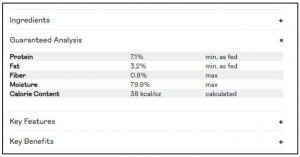
Best Dog Food for Weight Loss
Did you know that 53% of dogs are overweight? Yikes! Even a few extra pounds can lead to health problems down the road, including high blood pressure, diabetes, and heart disease. So while you might think your pudgy pooch looks cute, it’s important to get their weight in check.
Ideally, dogs should have an hourglass figure; if you’re looking straight down at them from above, their abdomen will be a bit narrower than their chest and hips. You can also examine their ribs. You should be able to feel them with light pressure, but not visibly see them.
Just remember: there’s no magic weight loss pill for dogs. As a pet parent, it’ll be your responsibility to monitor your pup’s weight and make changes if needed.
If your dog needs to lose some pounds, here are some things to keep in mind:
- Choose Your Food Wisely – Focus on meals with ingredients you can pronounce! Make sure it’s nutrient-dense, and avoid fillers and byproducts. The VCA offers a wise reminder on their site: when it comes to selecting the best food for your pup, get the highest-quality food you can afford.
- Don’t Ignore Treats & Snacks – Those treats can add up! If you’re doing a lot of reward-based training, you may want to adjust meals to accommodate the extra calories. Also, make sure to choose healthy dog treats instead of the calorie- and preservative-laden options you see in most stores.
Easy Weight Management with Pet Plate
Want to make life a little easier? With Pet Plate, you can keep your dog at a healthy weight and feel great about what you’re serving. Our healthy meals are made with real ingredients in a human-grade kitchen, with no artificial preservatives or gross byproducts. And with four delicious flavors to choose from, your pup will look forward to every meal.
Answer a few simple questions, and you’ll get a customized meal plan that’s perfect for your pup. Start now!